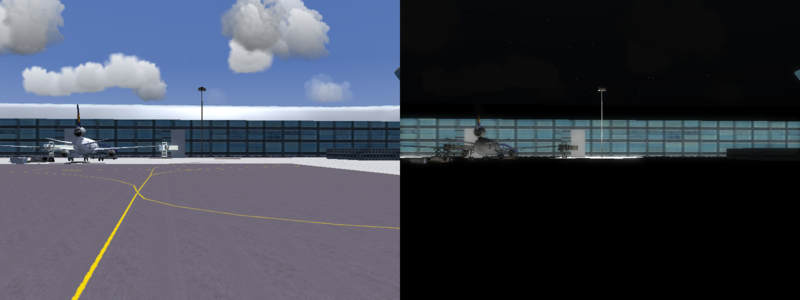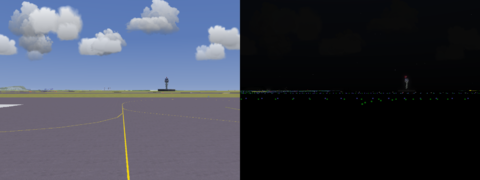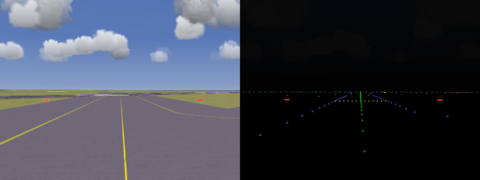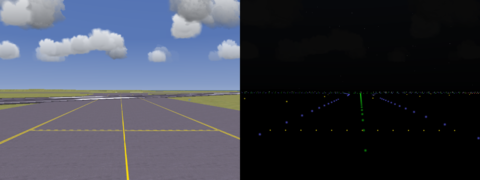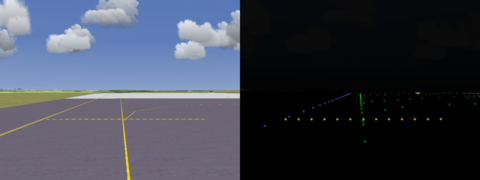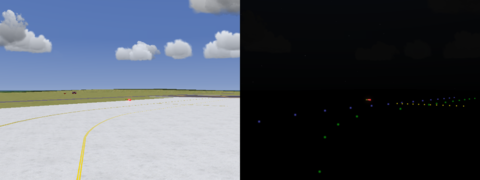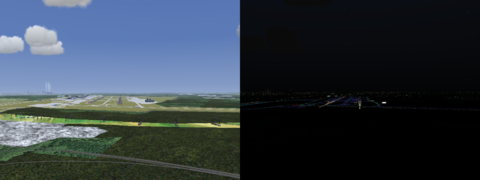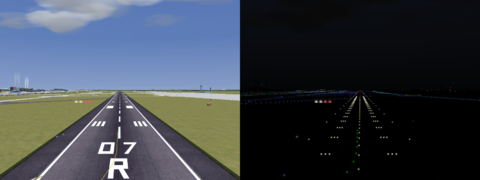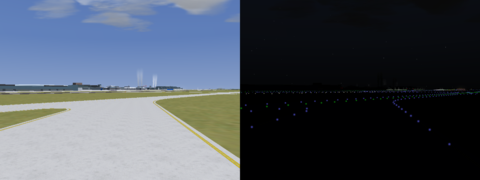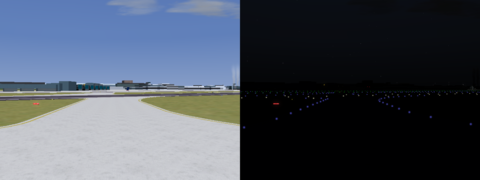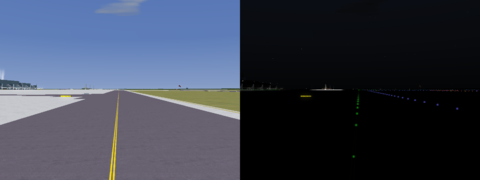User:F-WTSS/Brouillon Fr/Tutoriel CTA
| Air traffic control |
|---|
Lien vers l'article principal (en anglais) : Air traffic control
Le contrôle du trafic aérien (fréquemment abrévié en CTA, ou en anglais ATC pour Air traffic control) comporte un ensemble de procédures et de processus conventionnels pour maintenir l'écart entre les avions, éviter qu'ils se percutent, et leur éviter des turbulences atmosphériquess lors de leur passage dans un même espace aérien.
Cet article, plutôt destiné aux pilotes, illustre ces procédures. Il devrait aider à apprécier les zones contrôlées et celles des aéroports sur les serveurs multijoueurs de FlighGear.
Rôle du contrôleur
Le rôle assuré par le contrôleur s'assimile à celui rencontré dans des conditions réelles :
| Suffixe de position | Nom | Description |
|---|---|---|
| xxxx_DL | Délivrance de clairance | Vérifications (ou créations) des plans de vol soumis par les pilotes. Vérification qu'aucun appareil ne croise la route d'un autre au même moment. |
| xxxx_GN | Sol | Contrôle des mouvements au sol des appareils à un aéroport : bloc, parking, piste de roulage (taxiway). Délivrance des autorisations de roulage, assistance aux pilotes, selon nécessité. |
| xxxx_TW | Tour | Contrôle la piste d'atterrissage en service ainsi que l'espace aérien jusqu'à 10 nautiques (miles nautiques = 1,852 km) de l'aéroport ; choisit les pistes de décollage et d'atterrisage à mettre en service ; |
| xxxx_AP | Approche | Contrôle l'espace aérien depuis l'aéroport jusqu'à une distance de 30 NM ou une altitude de 18 000 pieds (habituellement) ; s'occupe de tous les appareils arrivant vers l'aéroport jusqu'à leur connexion sur l'ILS, ou jusqu'à ce qu'ils voient la piste, auquel cas ils confient l'avion à la tour ; |
| xxxx_DE | Départ | ce poste est rarement utilisé, sauf dans les aéroports très actifs ; Il s'occupe de tous les départs et les confie au CTR, ne laissant au contrôleur d'approche que la charge des arrivées ; |
| xxxx_CT | Centre | Les contrôleurs du Centre (de contrôle régional) sont chargés de la totalité de l'espace aérien non contrôlé par APP, DEP ou TWR ; Ils contrôlent les avions en phase de croisière, et les amènent de X à Y en sécurité, jusqu'à ce qu'ils puissent les conduire jusqu'à la descente et les confier aux contrôleurs d'approche[1]. |
- Dans ce tableau, "xxxx" remplace un code d'identification de zone utilisée par le contrôleur ; ce sont les codes OACI. Ils varient avec les aéroports et on les trouve sur la liste des codes d'aéroports. Par exemple, London Gatwick est "EGKK", et le contrôleur de la tour de Gatwickse présente comme EGKK_TW.
- Les contrôleurs du Centre régional disposent également d'un identifiant OACI ; ils ne relèvent pas d'un seul aéroport mais d'une zone plus vaste. Par exemple, LFFF_CT désigne le Centre régional de la France, and LFFF_FS le Flight Service Station de France.
- Sur les grands aéroports, plusieurs contrôleurs peuvent se partager un même poste.
Rôle du contrôleur sur FlightGear
Comme il n'y a pas beaucoup de contrôleurs aériens sur FlightGear, un même contrôleur occupe souvent plusieurs fonctions. En général :
- le contrôleur situé à un poste particulier occupe également les postes situés en dessous (listés dans le tableau ci-dessus) si personne ne s'en charge. Par exemple, si EGKK_TW (le contrôleur de la tour de Gatwick) est en ligne, mais s'il n'y a aucun EGKK_GN (contôleur au sol), le contrôleur de la tour agit également comme contrôleur sol.
- par exception à cette règle, les contrôleurs tour agissent fréquemment comme contrôleurs d'approche des aéroports respectifs.
Changement d'interlocuteur
Si plus d'un contrôleur s'occupe d'une zone, le premier contrôleur doit dire au pilote d'entrer en contact avec le second lorsque l'appareil est sur le point d'aborder son espace aérien. Cela se fait habituellement avec la phrase "Immatriculation, contactez station sur fréquence"
- où Immatriculation correspond au code d'identification de l'appareil ;
- station le contrôleur avec lequel le pilote doit poursuivre la procédure ;
- et fréquence, la fréquence radio sur laquelle communiquer.
Vol IFR et VFR
Lien vers l'article principal (en anglais) : Flight rules
Pour évoluer dans les zones contrôlées, la distinction entre les règles de vol VFR et celles de vol IFR est importante, puisque la planification des vols et la phraséologie diffèrent.
- les règles de vol VFR (abréviation de l'anglais Visual Flight Rules) s'appliquent lorsque la visibilité permet au pilote de s'orienter, de voir les autres avions et les obstacles, par exemple, avec un ciel exempt de nuages à basse altitude près de l'aéroport au décollage et à l'atterrissage, avec une lumière suffisante, avec peu ou pas de brouillard. On les utilise principalement en aviation générale.
- les rèègles de vol IFR (de l'anglais Instrument Flight Rules) s'appliquent dans tous les autres cas.
Trouver et lire des cartes
Lien vers l'article principal (en anglais) : Getting aeronautical charts
Il faut disposer des cartes aéronautiques des aéroports d'envol ou d'atterrissage, spécialement :
| Type de carte | Description |
|---|---|
| Information aéroportuaires | Description des caractéristiques de l'aéroport et liste des fréquences radio. |
| Sol (carte de l'aérodrome/diagramme de l'aéroport) | Description des pistes de roulage et d'envol spécifiques d'un aéroport ; utilisées pour le roulage depuis/vers le terminal. |
| SID/STAR | Utilisées pour les arrivées/départs aux instruments. |
| VFR | Utilisées pour les vols VFR. Elles décrivent habituellement un minimum d'altitudes de sécurité pour chaque zone, de même que les points de report (points au-dessus desquels on doit signaler sa position à l'ATC). |
Phraséologie, exemple de vol IFR
La phraséologie se présente au travers d'un exemple de vol IFR depuis LEBL (aéroport de Barcelone, en Espagne) à EDDF (Frankfort sur le Main, en Allemagne). Pour simplifier, on suppose que tous les postes de contrôleurs (autorisations, sol, tour, départ, centre et approche) sont occupés. On suppose que l'immatriculation de l'appareil est BAW1542 (épelé Speedbird un cinq quatre deux).
La phraséologie est présentée dans l'ordre des étapes successives d'un vol dont le lecteur est le pilote.
Planification du vol
Lien vers l'article principal (en anglais) : Flight planning
Si vous prenez l'habitude de déposer votre plan de vol sur le site web de Lenny, les contrôleurs peuvent connaître vos aéroports de départ/arrivée, votre route et votre altitude de croisière sans avoir besoin de vous interroger à chaque fois. C'est donc une bonne pratique.
Suivez les instructions de l'article Flight planning (Planning des vols, en anglais) pour enregistrer un vol de LEBL à EDDF, à l'altitude de croisière FL250.
Obtenir la clairance de départ
On commence au parking de l'aéroport, Terminal T1, bloc 221.
La première chose à faire consiste à vérifier la pression atmosphérique actuelle, et identifier la piste d'envol en service. En général, les avions s'orientent face au vent pour décoller et atterrir. Pour ce faire, il nous faut écouter l'ATIS (Automatic Terminal Information Service), un message préenregistré détaillé d'informations météorologiques utiles, la piste en sevice, et d'autres informations importantes pour les pilotes. Il est transmis en continu sur un canal dédié. La fréquence figure sur les cartes d'informations des aéroports, et est accessible par le menu AI -> ATC Services in Range -> LEBL ; dans notre cas, il s'agit de 121.970 MHz.
Nous allumons le panneau radio, et nous réglons la fréquence sur 121. 97, pour écouter les message ATIS (en anglais) :
- LEBL ATIS : This is El Prat information Alpha. Landing runway two five right. Departure runway two five left. Transition level five zero. Wind two zero zero degrees, one zero knots. Visibility one zero km or more, few two thousand five hundred feet. Temperature two two, dewpoint one zero. QNH one zero one eight. No significant change. On initial contact advise controller you have information Alpha.
- (Traduction : LEBL ATIS : Voici les informations Alpha pour El Prat. Atterrissage piste deux cinq droite. Départ piste deux cinq gauche. Niveau de transition cinq zéro. Vent deux zéro zéro degrés, unité zéro noeuds. Visibilité unité zéro kilomètres ou plus, quelques (nuages) deux mille cinq cent pieds. Température deux deux, point de rosée unité zéro. QNH unité zéro unité huit. Pas de changement important. Lors de votre premier contact, signalez au contrôleur que vous avez l'information Alpha.
Ce qui nous indique que :
- nous allons décoller depuis la piste 25L (25 gauche) ;
- nous devons caler l'altimètre sur 1018 hPa (hectoPascal)[2], puis ramener son règlage à la pression standard au niveau de transition (FL050, ou 5000 pieds).
- chaque émission ATIS est identifié par une lettre progressive suivant l'alphabet phonétique de l'OTAN ; nous devrons dire au controleur de délivrance que nous disposons de l'information "Alpha", qu'il puisse vérifier si nous disposons des dernières données.
Noter également que les nombres sont énoncés chiffre par chiffre pour plus de clarté. Ce sera le cas dans toutes les communications qui suivront.
Nous allons maintenant demander la clairance (c'est-à-dire l'autorisation de voler vers un aéroport de destination) du controleur de délivrance, en procédant ainsi :
- On recherche la fréquence du contr^ole de délivrance sur les carte d'information de l'aéroport ou bien les service ATC disponibles à proximité (Menu IA > Service ATC à proximité). Dans notre cas, la fréquence est 121.800 MHz). Nous règlons COM1 sur cette valeur (ou bien nous nous connectons sur Mumble et joignons le canal de délivrance, ou encore nous parlons simplement sur le Chat Multijoueur)[3].
- Nous contactons le contr^oleur pour lui demander la clairance (c'est au pilote d'initier le contact avec le CTA, pas l'inverse).
- Astuce : prenez note de la clairance sur un papier, car c'est difficile (et dangereux) de la mémoriser.
- Le controleur de délivrance nous donne la clairance qui comprend :
- notre indicatif ;
- si nous disposons du dernier jeu d'informations ATIS ;
- notre aéroport de destination ;
- le SID (départ normalisé aux instruments) et les points de passage de départ ;
- la route à suivre (si elle n'est pas mentionnée, nous suivrons celle figurant sur notre plan de vol) ;
- laltitude initiale et celle de croisière ;
- le squawk (code du transpondeur) à régler ;
- nous répétons ces éléments au controleur pour confirmer que nous avons bien compris la totalité correctement ;
- le contr^oleur corrige nos éventuelles erreurs et nous confie au contr^oleur de sol.
- BAW1542: El Prat Delivery, this is Speedbird one five four two, requesting delivery to Frankfurt, flight level two five zero, we have information Alpha.
- El Prat Delivery: Speedbird one five four two, Alpha is current, cleared to Frankfurt via OKABI three Whiskey, initial altitude five hundred feet, expect flight level two five zero after ten minutes, squawk four zero zero zero.
- BAW1542: Cleared to Frankfurt via OKABI three Whiskey, initial altitude five hundred feet, expect flight level two five zero after ten minutes, squawk four zero zero zero, Speedbird one five four two.
- El Prat Delivery: Speedbird one five four two, readback correct, contact El Prat Ground on one two one decimal six five zero.
- BAW1542: Contact El Prat Ground on one two one decimal six five zero, Speedbird one five four two.
The controller asked us to follow the OKABI3W SID after departure - get the SID charts, find it and look at the chart or read the text route descriptions. In this case, the SID prescribes pilots to climb to 500 ft, turn left to intercept radial 199 PRA and be at least at 2500 ft at 8 NM from PRA; intercept radial 287 VNV and pass VNV at 5000 ft; turn right to KARDO, pass KARDO at FL120 and proceed direct OKABI. If you've got the Level-D files from Navigraph, select the SID in the Route Manager dialog for the route to be automatically entered; otherwise, use the Route Manager to input the VORs and waypoints manually.
We also set the transponder code and switch the transponder to Ground mode (if the aircraft we're using supports this functionality).
Remorquage et démarrage
Before pushing back (being pushed away from the stand with a tug) and starting up, we need to get appropriate clearances from the Ground controller. This ensures we won't block taxiways unnecessarily.
- BAW1542: El Prat Ground, Speedbird one five four two at stand two two one, request pushback.
- El Prat Ground: Speedbird one five four two, El Prat Ground, pushback approved, facing south.
- BAW1542: Pushback approved, facing south, Speedbird one five four two.
We then push back, making sure the aircraft is turned towards ("facing") south at the end of the maneuver, and ask for permission to start our engines.
- BAW1542: Speedbird one five four two, request startup.
- El Prat Ground: Speedbird one five four two, startup approved.
- BAW1542: Startup approved, Speedbird one five four two.
After that, we start our engines and complete our checklists as quickly as possible.
Roulage jusqu'à la piste de décollage
We ask for clearance to taxi to the departure runway.
- BAW1542: Speedbird one five four two is ready to taxi.
- El Prat Ground: Speedbird one five four two, taxi to holding point Echo two via Lima and Echo, QNH one zero one eight.
- BAW1542: Taxi to holding point Echo two via Lima and Echo, QNH one zero one eight, Speedbird one five four two.
The current QNH may be repeated by the ground controller, even if we have just heard it on the ATIS, as a reminder to set it to the correct value - so check it. After that, open the ground chart and check your taxi route before starting, as in some cases taxi signs will not be present at all intersections. You will notice that the controller cleared us only to holding point E2, so, once there, we'll need to report our position and await further instructions. The holding point is marked by a stop bar (a dotted/continuous yellow line: the dotted one faces the runway while the continuous line faces the taxiway, to remind you that you need a clearance to cross the runway, and it is lit at night by means of pulsing yellow lights).
Taxi to E2 as instructed at a maximum speed of 30 knots and hold short (stop) just before the stop bar. Remember that, while the controller may instruct you to hold position (stop) and give way to another plane, it's still your responsibility not to collide with buildings, vehicles or other aircraft; also, should you at any point become unsure of your position, stop at once and ask the ground controller.
We contact the ground controller to tell him/her we're at E2.
- BAW1542: Speedbird one five four two, we're holding short Echo two.
- El Prat Ground: Speedbird one five four two, cleared to cross runway zero two, taxi to holding point Golf one via Echo one and Kilo.
- BAW1542: Cleared to cross runway zero two and taxi to holding point Golf one via Echo one and Kilo, Speedbird one five four two.
We then cross the runway without delay and turn left on K. Near K2 you can notice a CAT II/III holding point (marked by an empty yellow rectangle with vertical lines, equipped with fixed lights) - that's where we would stop if visibility was reduced or if another aircraft was landing using ILS; since that's not the case and we were cleared to G1, just proceed.
We stop at G1 while the ground controller instructs us to contact the tower:
- El Prat Ground: Speedbird one five four two, contact El Prat Tower on one one eight decimal three two zero, goodbye!
- BAW1542: Contact El Prat Tower on one one eight decimal three two zero, Speedbird one five four two, bye!
Alignement et décollage
We contact Tower on text chat, FGCom or Mumble (depending on the tools the controller is using) to get our takeoff clearance. It will include, in that order:
- the wind direction and speed;
- wind gusts, if any;
- warnings (like wake turbulence, rain...), if any;
- the runway number;
- the words cleared for takeoff.
- BAW1542: El Prat Tower, Speedbird one five four two, holding short Golf one.
- El Prat Tower: Speedbird one five four two, wind is two one zero at five, runway two five left, cleared for takeoff.
- BAW1542: Cleared for takeoff two five left, Speedbird one five four two.
| Note If a tower controller clears an aircraft for takeoff while it is still on a taxiway, the pilot is also cleared to enter the runway – there is no need to issue a separate line up and wait instruction. |
We set the transponder to On so that the controllers and other aircraft will be able to see us on radar screens and the TCAS, line up, take off and follow the SID. After the takeoff, the tower controller will hand us off to the departure controller:
- El Prat Tower: Speedbird one five four two, contact Departure on one two six decimal five zero zero, goodbye!
- BAW1542: Contact Departure on one two six decimal five zero zero, Speedbird one five four two.
We switch to the departure frequency and contact the controller:
- BAW1542: El Prat Departure, Speedbird one five four two passing current altitude, OKABI three Whiskey departure.
- El Prat Departure: Speedbird one five four two, radar contact, climb and maintain flight level two five zero.
- BAW1542: Climb and maintain flight level two five zero, Speedbird one five four two.
We climb to FL250 and continue following the SID waypoints. When we're approaching the final fix (OKABI) the controller will tell us to follow our flightplan:
- El Prat Departure: Speedbird one five four two, resume your own navigation, frequency change approved, goodbye!
- BAW1542: Resuming our own navigation, frequency change approved, Speedbird one five four two, bye!
We're now free to follow our flightplan - it's a good practice to keep an eye on the multiplayer map to check for traffic and to announce altitude changes/turns on text chat if other pilots are nearby.[4]
Approche de l'aéroport de destination
We start descending on our own so as to reach FL150 approximately 100 NM from the destination airport. When we're about 80 NM from EDDF we check the ATIS for the destination airport, just like we did at LEBL - in this case the frequency is 118.02. We tune in the COM1 radio to that frequency and listen:
- EDDF ATIS: This is Frankfurt information Echo. Landing runway zero seven right. Departure runway zero seven center. Transition level five zero. Wind zero two zero degrees, four knots. Visibility one zero km or more, few four thousand eight hundred feet. Temperature one niner[5], dewpoint zero seven. QNH one zero one eight. No significant change. On initial contact advise controller you have information Echo.
We then contact the approach controller (in this case Langen Radar, 118.45 MHz):
- BAW1542: Langen Radar, Speedbird one five four two at flight level one five zero, we have information Echo.
- Langen Radar: Speedbird one five four two, radar contact, Echo is current, descend and maintain five thousand feet, proceed direct UNOKO.
- BAW1542: Descend and maintain five thousand feet, proceed direct UNOKO, Speedbird one five four two.
We proceed to the UNOKO waypoint and descend to 5000 ft, as instructed. At 5000 ft we set the altimeter to the local QNH (1018 hPa).
When we're near UNOKO the approach controller will contact us and assign us a STAR (standard arrival route):
- Langen Radar: Speedbird one five four two, cleared UNOKO one Mike arrival.
- BAW1542: Cleared UNOKO one Mike arrival, Speedbird one five four two.
Now we follow the altitudes and route in the STAR – in this case, we fly over UNOKO, IBVIL, MANUV, RAMOB and proceed to TAU.
We hold (circle) over TAU until the controller instructs us to continue the approach:
- Langen Radar: Speedbird one five four two, turn right heading one four zero, descend and maintain three thousand feet, reduce speed to two five zero knots.
- BAW1542: Turn right heading one four zero, descend and maintain three thousand feet, reducing speed to two five zero knots, Speedbird one five four two.
We now engage the autopilot's heading select mode, fly the given heading, reduce our speed and continue our descent as cleared. After a couple of minutes, the controller calls us and instructs us to use the Instrument Landing System to get towards the runway:
- Langen Radar: Speedbird one five four two, cleared ILS approach runway zero seven right.
- BAW1542: Cleared ILS approach runway zero seven right, Speedbird one five four two.
As soon as the localizer is alive we engage the autopilot's localizer mode and, as soon as the glideslope is alive, we switch to approach mode and descend on the glide. The controller will call us one last time to hand us over to Frankfurt Tower:
- Langen Radar: Speedbird one five four two, contact Frankfurt Tower on one one niner decimal niner zero.
- BAW1542: Contact Frankfurt Tower on one one niner decimal niner zero, Speedbird one five four two.
Atterrissage
We switch to 119.90 MHz and/or join the Frankfurt Tower channel on Mumble, then contact the tower controller to get the landing clearance. It will include:
- the wind direction and speed;
- wind gusts, if any;
- warnings (like wake turbulence, rain...), if any;
- the runway number;
- the words cleared to land.
- BAW1542: Frankfurt Tower, Speedbird one five four two, ILS approach runway zero niner right.
- Frankfurt Tower: Speedbird one five four two, Frankfurt Tower, wind zero one zero degrees, five knots, runway zero seven right, cleared to land.
- BAW1542: Cleared to land, runway zero seven right, Speedbird one five four two.
We land on 07R and vacate (exit) the runway at the earliest opportunity, making sure not to block other aircraft and not to enter a taxiway marked with a NO ENTRY sign; in this case, we vacate on the left, since the terminal is on the left. (On occasion, the controller will ask us to vacate on a specific side or to use a specific exit). We are now asked to switch to Ground:
- Frankfurt Tower: Speedbird one five four two, contact Frankfurt Ground on one two one decimal eight zero.
- BAW1542: Contact Frankfurt Ground on one two one decimal eight zero, Speedbird one five four two.
Roulage jusqu'au bloc et arrêt
We switch the transponder to ground mode and check the ground chart to get the name of the taxiway we are on; in our case, we have vacated the runway on taxiway M15. We then contact the ground controller:
- BAW1542: Frankfurt Ground, Speedbird one five four two on Mike one five, runway zero seven right vacated.
- Frankfurt Ground: Speedbird one five four two, Frankfurt Ground, taxi to holding point Mike one four via Mike, hold short of Mike one four.
- BAW1542: Taxi to holding point Mike one four via Mike, hold short of Mike one four, Speedbird one five four two.
We taxi to holding point M14, stop and report our position to the controller, so that (s)he can coordinate with Tower and clear us to cross the active runway 07C.
- BAW1542: Speedbird one five four two, holding short Mike one four.
- Frankfurt Ground: Speedbird one five four two, standby. (The controller will ask Tower for crossing clearance – it might take a bit.)
- Frankfurt Ground: Speedbird one five four two, cleared to cross zero seven center, taxi to Lima via Lima niner.
- BAW1542: Cleared to cross zero seven center, taxi to Lima via Lima niner, Speedbird one five four two.
At this point, we resume taxiing, making sure to cross the runway expeditiously.
Since the taxiways and the apron are managed by two different controllers, the ground controller will hand us off to the apron controller:
- Frankfurt Ground: Speedbird one five four two, contact Apron East on one two one decimal niner five.
- BAW1542: Contact Apron East on one two one decimal niner five, Speedbird one five four two.
We switch to the new frequency and report:
- BAW1542: Apron East, Speedbird one five four two on Lima nine, request taxi to the stand.
- Apron South: Speedbird one five four two, Apron East, taxi to stand Delta five via Lima and November one.
- BAW1542: Taxi to stand Delta five via Lima and November one, Speedbird one five four two.
We taxi to the stand and shut down, also switching the transponder off – there's no need to ask a clearance for that. Our flight is now finished.
Tutoriel en video
The departure and arrival presented in this tutorial have also been recorded. Some interactions were simplified, the result should however be more close to what you usually experience on the multiplayer network. Closed captions are available.
Exemple de vol VFR
de profundis has written a VFR tutorial that takes you for a sample flight from KRNO (Reno Tahoe) to KBIH (Eastern Sierra Regional) and covers VFR flight planning, phraseology and tips in great detail. You can get his Cross Country Tutorial from the dedicated forum thread.
Astuces
- This tutorial, for the sake of simplicity and brevity, assumed no other aircraft was present. On multiplayer servers you might be instructed to hold your position, give way to other aircraft or hold (make circles) over a point to remain separate from other aircraft; check the ATC phraseology page for the specific phraseology used in those situations.
- Follow the guidelines detailed in ATC best practices to make the experience enjoyable for everyone.
- When practicing controlled flying, make sure you know your aircraft well (you should be able to maintain an assigned speed, altitude and heading), go to a less trafficked airport and tell the controller it's your first time interacting via ATC.
- Remember to read back (repeat) the clearances; it is the only way for the controller to know whether you received them correctly or not.
- Execute the clearances while reading them back.
Notes
- ↑ Dans certaines zones comme la France, les contrôleurs du Centre disposent du soutien supplémentaires des Flight Service Stations (FSS), qui fournissent aux pilotes des informations utiles (météo, fréquences...) et n'offrent pas de contrôle de trafic aérien.
- ↑ Les aéroports européens utilisent généralement les hectopascals (hPa) pour le QNH (pression barométrique ou plus précisément "pression atmosphérique réduite au niveau de la mer selon les conditions de l'atmosphère standard", alors que les aéroports américains recourrent aux pouces de mercure (inHg). Certains avions permettent indifféremment la saisie du QNH avec l'une ou l'autre unité. Si ce n'est pas le cas, vous devrez utiliser un convertisseur.
- ↑ Chaque contr^oleur est libre de choisir l'utilisation de FGCom, de Mumble ou simplement le chat textuel, comme il ou elle l'entend ; généralement, tout le monde accepte l'ATC via le chat et, si des communications vocales sont proposées, c'est annoncé lors du premier contact. Préférez la communication verbale, si possible, plus réaliste et parce que parler est plus rapide que la saisie au clavier.
- ↑ In real world flying, we would be handed off to center controllers and we would report our position over special points, marked as black triangles in the charts. Since center controllers are not common in FlightGear, this is not usually done.
- ↑ "Niner" is used instead of "nine" to avoid confusion between the similarly sounding "nine" and "five".
[[Category:Air Traffic Control]]
